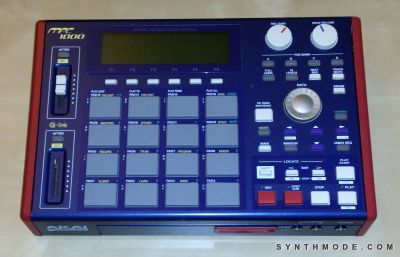AKAI MPC 1000

The MPC is THE icon of sample-based music--more specifically hip-hop. While there is an entire line of MPC's out there, what makes the MPC 1000 model special is its portability and power although not right out of the box.
In order to unlock the MPC 1000's full potential one must install an aftermarket operating system: JJOS. JJ stands for Japanese Jenius, referring to the person who coded the operating system. JJOS comes in different flavors. There is a free version, which is still a big improvement over the AKAI version, and other paid versions, which can be unlocked by purchasing a machine-specific code directly from JJ himself. The top-of-the-line operating system is JJOS2XL and it's about $125. This version super charges your MPC with features only found in other top-of-the-line MPC's. One thing you don't get is the actual physical characteristics of the better MPC's, which opens up an unpleasant topic for many MPC 1000 owners.
The first issue of the MPC 1000 (blue) had a major design flaw in its pad sensor system. The pads were based on an individual sensor design in which pads lost their sensitivity within months of regular use. AKAI issued a revision after coming out with a black version of the MPC 1000 (note: not all black MPC 1000's are revised). The revision consisted of a new pad and sensor mechanism consisting of a single pad sheet where all pads were connected and a single sensor platform with greatly improved lifespan. There was still a major flaw: the pads had a tiny gap that separated them from the sensor and this greatly hindered the responsiveness of the pads.
The MPC 1000 was so powerful and affordable for its time that it gained massive popularity. Many of its users soon became aware of its design flaws, and this created a demand for repair products. MPCStuff.com and VSTservice.com are two of the few (if not the only) to sell replacement pads and sensors for the MPC 1000, but these upgrades do not come cheap. A DIY upgrade kit to fix the old pads will cost you $200, and these are the only two companies who seem to be selling them. Once you have the new pads, you will likely need to buy their "corx"-enabled single-pad sheet which will close the tiny gap between the sensor and the pads--for some reason they don't include these pads with the upgrade kit... that reason likely being to make more money.
Last buy not least, AKAI used about 30 cheap tactile switches with short life expectancy on all of their MPC 1000's. These tactile switches have 4 solder points each, so changing them is either going to be very costly or time consuming.
To summarize: if you wanted to get a full-featured and perfectly working mpc1000 you would need to buy an mpc 1000 (used for about $450), unlock JJOS2XL ($125), get a pad upgrade kit ($200), and the "corx" pads ($20), and replace tactile switches (~$100 depending on how you decide to do this)... you are talking about almost $900 and a lot of time and effort. See my MPC 1000 Blues entry to learn about a few DIY upgrades I've done to my MPC 1000.
Is it all worth it? Only you can decide. The limitation and advantages of the MPC workflow unlock a creative process and yield results that even more powerful sequencers cannot--and the same applies to other platforms, whether more sophisticated or not.



Add new comment